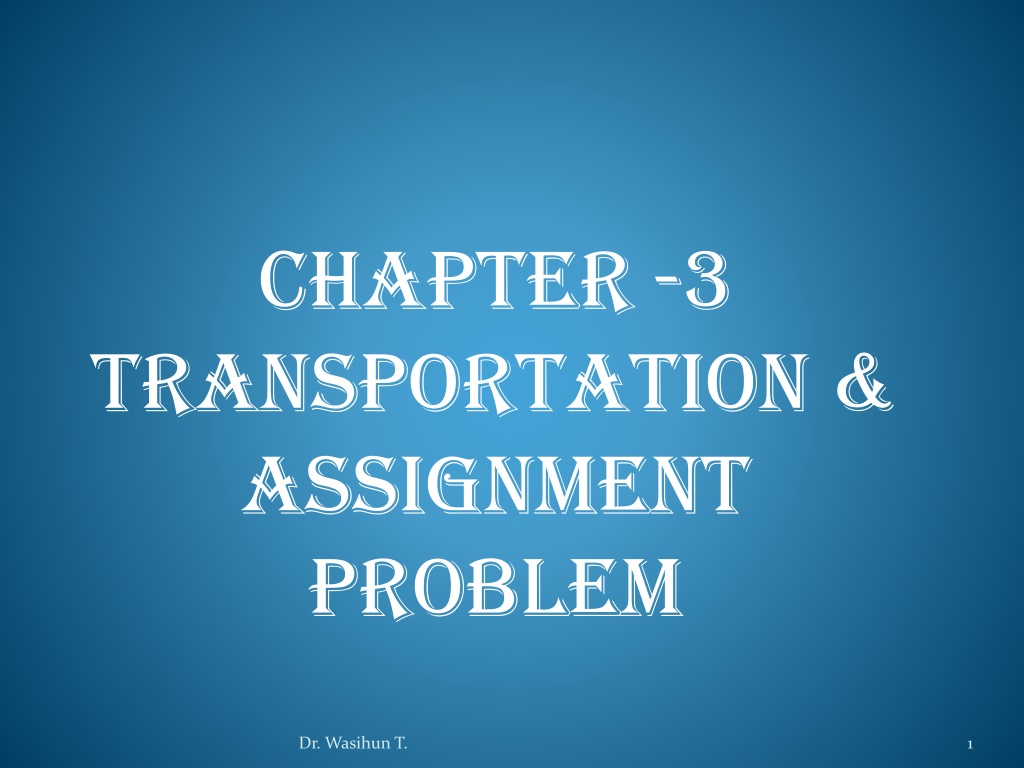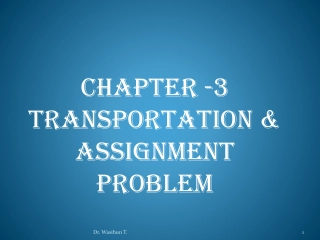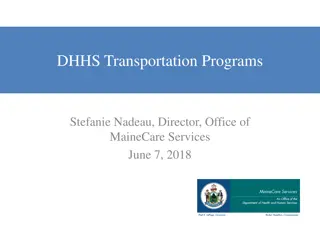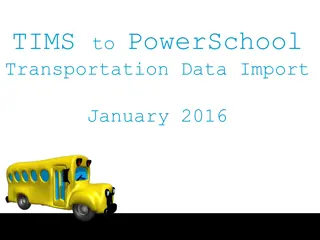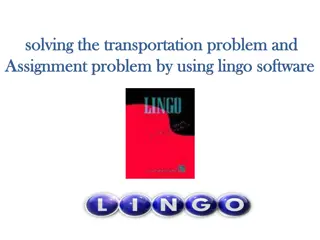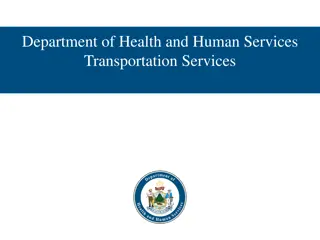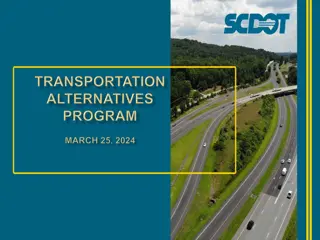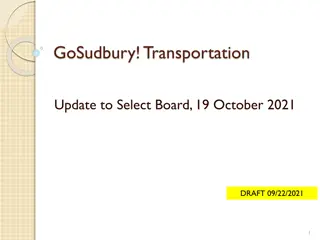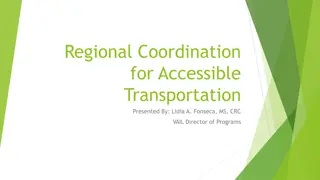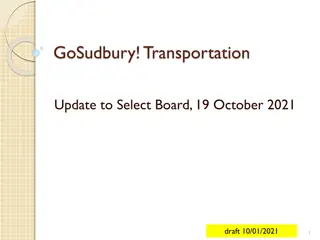Understanding Transportation and Assignment Problem
Transportation and assignment problems involve optimizing the shipment of goods from various sources to multiple destinations while minimizing total transportation costs. These problems deal with limited supply, known demand, constant shipping costs, and integer quantities. The transportation algorithm assumes homogeneous goods, linear transportation costs, and total supply equal to total demand. Formulating a transportation model requires information on supply quantities, demand quantities, and unit transportation costs for each origin-destination route.
Download Presentation

Please find below an Image/Link to download the presentation.
The content on the website is provided AS IS for your information and personal use only. It may not be sold, licensed, or shared on other websites without obtaining consent from the author. Download presentation by click this link. If you encounter any issues during the download, it is possible that the publisher has removed the file from their server.
E N D
Presentation Transcript
CHAPTER -3 TRANSPORTATION & ASSIGNMENT PROBLEM Dr. Wasihun T. 1
3.1 Transportation problem Transportation problem Transportation problems deals with shipments from a number of source to a number of destinations. Typically each source is supply limited, each destination has known demand and the shipment cost between sources and destinations are given. The objective of such models is to determine how many units should be shipped from each source /origin to each destination so that total transportation costs are minimized. Dr. Wasihun T. 2
3.1.1 Characteristics of transportation problems 1. A limited supply of commodity is available at certain sources or origins such as factories. 2. There is a demand for the commodity at several destinations such as warehouse, distribution centers 3. The quantity of supply at each source and the demand or requirements at each destination is assumed to be constant. 4. The shipping (transportation ) costs per unit from each source to each destination are assumed to be constant. Dr. Wasihun T. 3
Cont 5. No shipments are allowed between sources or between destinations and again all supply and demand quantities are given in whole numbers (integers) 6. The problem is to determine how many units to ship from each source to each destinations so that all demand are satisfied at the minimum total shipping cost. Dr. Wasihun T. 4
Assumptions The transportation algorithm requires the assumption that: All goods be homogeneous, so that any origin is capable of supplying any destination, Transportation costs are a direct linear function of the quantity shipped over any route The total quantity available is equal to the total demand Dr. Wasihun T. 5
3.1.2 Formulating transportation Model A transportation problem typically involves a set of sending locations, which are referred to as origins, and a set of receiving locations, which are referred to as destinations. In order to develop a model of a transportation problem, it is necessary to have the following information : a. Supply quantity (capacity) of each origin. b.Demand quantity of each destination. c.Unit transportation cost for each origin-destination route. Dr. Wasihun T. 6
Example : Transportation table To Project #1 C11 C21 C31 Project #2 C12 C22 C32 Project #3 C13 C23 C33 Supply From Farm A Farm B Farm C Demand S1 S2 S3 D1 D2 D3 Dr. Wasihun T. 7
3.2 Methods for Finding Initial Solution There are three method to find initial feasible solution. 1. The Northwest-corner method. 2. Least cost method (An intuitive approach) 3. Vogel s Approximation Method Dr. Wasihun T. 8
1. The Northwest-corner method(NCM) The northwest corner method is a systematic approach for developing an initial feasible solution. Its chief advantages are that it is simple to use and easy to understand. Its chief drawback is that it does not take transportation costs into account. The northwest corner method gets its name because the starting point for the allocation process is the upper left-hand (Northwest) corner of the transportation table. For the ABC company problem, this would be the cell that represents the route from Farm A to Project #1. The following set of principles guides the allocation: Dr. Wasihun T. 9
Cont i. Begin with the upper left-hand cell, and allocate as many units as possible to that cell. This will be the smaller of the row supply and the column demand. Adjust the row and column quantities to reflect the allocation. ii. Remain in a row or column until its supply or demand is completely exhausted or satisfied, allocating the maximum number of units to each cell in turn, until all supply has been allocated (and all demand has been satisfied because we assume total supply and demand are equal). Dr. Wasihun T. 10
Example : 1. ABC company has contracted to provide topsoil for three residential housing developments. Topsoil can be supplied from three different farms as follows: Farm Weekly capacity (cubic yards) A 100 B 200 C 200 Demand for the topsoil generated by the construction projects is: Project Weekly demand(cubic yards) 1 50 2 150 3 300 Dr. Wasihun T. 11
Cont The manager of the ABC company has estimated the cost per cubic yard to ship over each of the possible routes: Cost per cubic yard to From Project #1 Project #2 Project #3 Farm A Birr4 Birr 2 Birr 8 Farm B 5 1 9 Farm C 7 6 3 Required a. Solve the problem by north west-corner method ? Dr. Wasihun T. 12
Solution The first step is to arrange the information into a transportation table. This is shown in the following table: To Project #1 Project #2 Project #3 Supply From Farm A Farm B Farm C Demand 4 5 7 2 1 6 8 9 3 100 200 200 500 50 150 300 Dr. Wasihun T. 13
Initial Feasible Solution To Project #1 Project #2 Project #3 Supply From Farm A 4 2 8 100 50(first) 50(second) Farm B 5 1 9 200 100(third) 100(fourth) Farm C 7 6 3 200 200(last) Demand 50 150 300 500 Dr. Wasihun T. 14
Cont The total cost is found by multiplying the quantities in completed (i.e. non empty) cells by the cell s unit cost and, then, summing those amounts. Thus: Total cost = 50(4) + 50(2) + 100(1) + 100(9) + 200(3) = $1900 Dr. Wasihun T. 15
2. Least Cost Method(LCM) This approach, also known as the minimum-cost method, uses lowest cell cost as the basis for selecting routes. The procedure is as follows: i. Identify the cell that has the lowest unit cost. If there is a tie, select one arbitrarily. Allocate a quantity to this cell that is equal to the lower of the available supply for the row and the demand for the column. ii. Cross out the cells in the row or column that has been exhausted (or both, if both have been exhausted), and adjust the remaining row or column total accordingly. iii. Identify the cell with the lowest cost from the remaining cells. Allocate a quantity to this cell that is equal to the lower of the available supply of the row and the demand for the column. iv. Repeat steps (ii) and (iii) until all supply and demand have been exhausted. Dr. Wasihun T. 16
Example : 1. ABC company has contracted to provide topsoil for three residential housing developments. Topsoil can be supplied from three different farms as follows: Farm Weekly capacity (cubic yards) A 100 B 200 C 200 Demand for the topsoil generated by the construction projects is: Project Weekly demand(cubic yards) 1 50 2 150 3 300 Dr. Wasihun T. 17
Cont The manager of the ABC company has estimated the cost per cubic yard to ship over each of the possible routes: Cost per cubic yard to From Project #1 Project #2 Project #3 Farm A Birr4 Birr 2 Birr 8 Farm B 5 1 9 Farm C 7 6 3 Required a. Solve the problem by least cost method ? Dr. Wasihun T. 18
Cont The first step is to arrange the information into a transportation table. This is shown in the following table: To Project #1 Project #2 Project #3 Supply From Farm A Farm B Farm C Demand 4 5 7 2 1 6 8 9 3 100 200 200 500 50 150 300 Dr. Wasihun T. 19
Cont Initial Feasible Solution for the ABC company using the LCM To From Farm A 4 50 Project #1 Project #2 Project #3 Supply 2 8 100 50 Farm B 5 1 9 200 150 50 Farm C 7 6 3 200 200 Demand 50 150 300 500 Dr. Wasihun T. 20
Cont Therefore : Total cost = 50(4) + 50(8) + 150(1) + 50(9) + 200(3) = $1800 Dr. Wasihun T. 21
3. Vogels Approximation Method (VAM) The third method for determining an initial solution is based on the concept of penalty cost or regret. If a decision maker incorrectly chooses from several alternative courses of action, a penalty may be suffered (and the decision maker may regret the decision that was made). In transportation problem, the courses of action are the alternative routes and a wrong decision is allocating to a cell that does not contain the lowest cost. Dr. Wasihun T. 22
Cont With VAM the basis of allocation is unit cost penalty i.e. that column or row which has the highest unit cost penalty (difference between the lowest and the next highest cost) is selected first for allocation and the subsequent allocations in cells are also done keeping in view the highest unit cost penalty Dr. Wasihun T. 23
Steps in VAM Operational steps: Step 1: for each column and row, determine its penalty cost by subtracting their two of their least cost . Step 2: select row/column that has the highest penalty cost in step 1 Step 3: assign as much as allocation to the selected row/column that has the least cost Step 4: Block those cells that cannot be further allocated Step 5: Repeat above steps until all allocations have been assigned Dr. Wasihun T. 24
Example From To A B C Supply 1 2 3 Demand 6 7 4 8 10 11 12 150 175 275 600 11 5 200 100 300 Dr. Wasihun T. 25
Subtracting their two of their least cost Step 1 (8-6) (11-7) (5-4) (6-4) (8-5) (11-10) Dr. Wasihun T. 26
Steps 2 & 3 Step 2: Highest penalty cost Step 3: this has the least cost Dr. Wasihun T. 27
Step 4 --- --- Dr. Wasihun T. 28
Step 5 Second Iteration --- --- --- Dr. Wasihun T. 29
3rd Iteration of VAM --- --- --- --- Dr. Wasihun T. 30
Initial tableau for VAM Dr. Wasihun T. 31
Cont Therefore; Total cost = (150x10)+(7x125) +(25x4)+(100x5)+(150x12)= $5,125 Dr. Wasihun T. 32
Evaluating a Solution for Optimality There are two methods. Such as: The Stepping-stone method 1. The MODI method 2. Dr. Wasihun T. 33
1. The Stepping-stone method The Stepping-stone method involves tracing a series of closed paths in the transportation table, using one such path for each empty cell. The path represents a shift of one unit into an empty cell, and it enables the manager or analyst to answer a what-if question The stepping-stone path also can be used to determine the maximum number of units that can be shifted into the empty cell, as well as modifications to other completed cells needed to compensate for the shift into the previously unused cell. Dr. Wasihun T. 34
Cont Rules for tracing Stepping-stone paths: i. All unoccupied cells must be evaluated. Evaluate cells one at a time. ii. Except for the cell being evaluated, only add or subtract in occupied cells. (It is permissible to skip over unoccupied cells to find an occupied cell from which the path can continue.) iii. A path will consist of only horizontal and vertical moves, starting and ending with the empty cell that is being evaluated. iv. Alter + and . signs, beginning with a + sign in the cell being evaluated. Dr. Wasihun T. 35
Cont The general implication of the plus and minus signs is that cells with + signs mean one unit would be added, cells with a minus(-) sign indicate one unit would be subtracted. Example: Dr. Wasihun T. 36
Cont Let consider the following initial tableau from the Min Cost algorithm There are Non-basic variables These are basic variables Dr. Wasihun T. 37
Stepping stone - + + - The above saying that, we add min value of all ve cells into cell that has + sign, and subtracts the same value to the -ve cells Thus, max ve is min (200,25) = 25, and we add 25 to cell A1 and B3, and subtract it from B1 and A3 Dr. Wasihun T. 38
Stepping stone The above tableaus give min cost = 25*6 + 120*10 + 175*11 175*4 + 100* 5 = $4525 Dr. Wasihun T. 39
2. The Modified Distribution Method (MODI) MODI is a modified version of the stepping-stone method in which math equations replace the stepping-stone paths. - In the table, the extra left-hand column with the ui symbols and the extra top row with the vj symbols represent values that must be computed. - Computed for all cells with allocations : ui + vj = cij = unit transportation cost for cell ij. Dr. Wasihun T. 40
Cont There are five steps: such as 1. Develop an initial solution. 2. Compute the ui and vj values for each row and column. 3. Compute the cost change, kij, for each empty cell. 4. Allocate as much as possible to the empty cell that will result in the greatest net decrease in cost (most negative kij) 5. Repeat steps 2 through 4 until all kij values are positive or zero Dr. Wasihun T. 41
Example Initial feasible solution Total cost= (8*25)+(125*10)+(175*11)+(200*4)+(75*5)=4450 From TO A B C Supply 1 6 8 10 150 25 125 2 7 11 11 175 175 3 4 5 12 275 200 200 75 100 Demand 300 600 Dr. Wasihun T. 42
Solution The Minimum Cell Cost Initial Solution Dr. Wasihun T. 43
The Modified Distribution Method (MODI) (2 of 6) - Formulas for cells containing allocations: x1B: u1 + vB = 8 x1C: u1 + vC = 10 x2C: u2 + vC = 11 x3A: u3 + vA = 4 x3B: u3 + vB = 5 The Initial Solution with All ui and vj Values - Five equations with 6 unknowns, therefore let u1 = 0 and solve to obtain: vB = 8, vC = 10, u2 = 1, u3 = -3, vA= 7 Dr. Wasihun T. 44
The Modified Distribution Method (MODI) (3 of 6) - Each MODI allocation replicates the stepping-stone allocation. - Use following to evaluate all empty cells: cij - ui - vj = kij where kij equals the cost increase or decrease that would occur by allocating to a cell. - For the empty cells in Table : x1A: k1A = c1A - u1 - vA = 6 - 0 - 7 = -1 x2A: k2A = c2A - u2 - vA = 7 - 1 - 7 = -1 x2B: k2B = c2B - u2 - vB = 11- 1 - 8 = +2 x3C: k3C = c3C - u3 -vC = 12 - (-3) - 10 = +5 Dr. Wasihun T. 45
The Modified Distribution Method (MODI) (4 of 6) - After each allocation to an empty cell, the ui and vj values must be recomputed. The Second Iteration of the MODI Solution Method Dr. Wasihun T. 46
The Modified Distribution Method (MODI) (5 of 6) Recomputing ui and vj values: - x1A: u1 + vA = 6, vA = 6 x1C: u1 + vC = 10, vC = 10 x2C: u2 + vC = 11, u2 = 1 x3A: u3 + vA = 4, u3 = -2 x3B: u3 + vB = 5, vB = 7 The New ui and vj Values for the Second Iteration Dr. Wasihun T. 47
The Modified Distribution Method (MODI) (6 of 6) - Cost changes for the empty cells, cij - ui - vj = kij; x1B: k1B = c1B - u1 - vB = 8 - 0 - 7 = +1 x2A: k2A = c2A - u2 - vA = 7 - 1 - 6 = 0 x2B: k2B = c2B - u2 - vB = 11 - 1 -7 = +3 x3C: k2B = c2B - u3 - vC = 12 - (-2) - 10 = +4 - Since none of the values are negative, solution obtained is optimal. - Cell 2A with a zero cost change indicates a multiple optimal solution. Therefore : Total cost: (6*25)+(10*125)+(11*175)+(175*4)+(5*100)=4525 Dr. Wasihun T. 48
SPECIAL ISSUES Alternate Optimal Solutions- Sometimes, transportation 1. problems have multiple optimal solutions. In such instances, it can be useful for a manager to be aware of alternate solutions, because this gives the manager an option of bringing non-quantitative considerations into the decision. Degeneracy- A solution is degenerate if the number of occupied 2. cells is less than the number of rows plus the number of columns minus one. i.e., there are too few occupied cells to enable all the empty cells to be evaluated (m+n-1 >number of occupied cell). Dr. Wasihun T. 49
Cont 3. Unacceptable Routes-In some cases, an origin-destination combination may be unacceptable. This may be due to weather factors, equipment breakdowns, labor problems, or skill requirements that either prohibit, or make undesirable, certain combinations (routes). 4. Unequal Supply and Demand- if supply and demand are not equal so, it is necessary to modify the original problem so that supply and demand are equal. This is accomplished by adding either a dummy column or a dummy row. Dr. Wasihun T. 50
